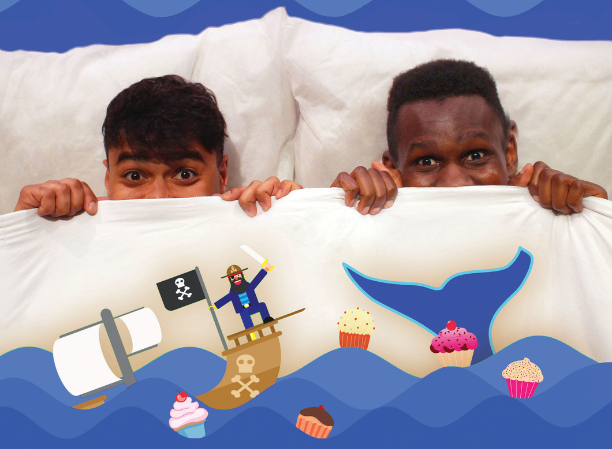Ten in the Bed is written by award-winning teenage fiction writer Steve Tasane (Child I, Blood Donors) and sensitively explores the child refugee experience, where the power of imaginary play offers an escape from reality. It is a humorous and inventive new show for ages 3-8 that celebrates the power of imaginary play and proves there’s always enough room to have fun, even when the world is at its most daunting.
Ten in the Bed is the latest production from Half Moon, the UK’s leading small-scale young people’s venue and touring company, winner of four Off West Theatre Awards for Theatre for Young People.
Tell me more about Ten in the Bed, what is the show about?
It is about how play, laughter and imagination create a home. At the beginning of the play, the boys in the bed are hungry and timid; they are a little bit lost. They know where they’ve come from, but have no idea where they are. As they relive their journey through silliness and play, the room they have found themselves in comes to feel warmer, more welcoming. As they play together, and bond through their nighttime adventures, they increasingly feel at home.
It is play within a play. Laughter overcomes fear; games make the boys feel stronger together. For the weak, the tiny and the hungry. The only tool they have with which to protect themselves is laughter.
Why did you want to write Ten in the Bed?
I wanted to write a play for young children that would delight and entertain, but with a serious underlying message that would be felt rather than told. I wanted the boys in the bed to be the agents of their own recovery, to take charge of life events that had always been totally out of their control; for the boys to reconstruct their own narrative – the story of the refugee journey. A journey that ends with full bellies, a roomful of toys and – crucially – a bed which always has enough space for them all to sleep easy and warm.
What was the inspiration for the show?
The power and magic of wishful thinking. The indefatigable power of the imagination. And, of course, the childhood song, which reminded me of sharing a bed with one of my brothers throughout my childhood, and once, staying at our uncle’s house where there was only one bed for the four of us brothers to sleep in – and I was the little one!
What were you trying to achieve with the play?
I wanted to show that there is always hope, and that hope is born in the mind of a child. Hope is shattered by the weapons of men. But children will always be born, children will always keep on coming, and they arrive with laughter and play and love and belonging – the most potent weapons on the planet.
How did the piece come to fruition?
I was one of the artists engaged in Half Moon’s Narratives of Empathy and Resilience – a brilliant title in itself! Artists working in all different forms came together to play – like the Big Kids we are – and create – like the Freelance Artists we are – in a safe space where we could inspire each other and be nurtured by the Half Moon team, given an opportunity to sound out our ideas and have the privilege of seeing snippets of our ideas acted out by real actors, with real directors, real technicians and designers, on the Half Moon stage, to get an idea of how our theatrical nuggets might look if they became actual, real touring pieces of theatre. The full commission came from that.
Why do the issues in Ten in the Bed particularly resonate with you?
I think because I lost my three brothers, over the years, to the long-term effects of childhood trauma, and I found that incredibly painful. It made me long for the days of our childhoods, the endless summer afternoons of playing games, losing ourselves in our imaginations, and being able to forget the stresses of the real world that surrounded us. We felt safe in those moments, safe with each other, and free. I wanted to harness that power and revisit that sense of comfort.
Ten in the Bed celebrates the power of imaginary play. Why is this so important?
Imaginary play is the first step of an artist’s journey. It is shaping a narrative in whatever way we wish to shape it. It is self-made therapy. If we lose that sense of play, we lose ourselves. This is why all creative narratives – novels, musicals, soap operas, comic books, movies, pop songs and poetry – remain vital to our wellbeing as adults and continue to do so through old age. It begins with the child playing ‘let’s pretend’. I wanted Ten In The Bed to embrace that philosophy.
What can audiences look forward to?
Sharks getting bonked on the head. Pirate jokes. Giant slices of toast roll over the ocean waves like edible life rafts. Cake, and more cake! The sillibilliness of midnight chitterchat.
Describe the show in three words.
Family. Fun. Friendship.
What would you like audiences to take with them after seeing the show?
I’d like them to feel buzzed up and want to invent fresh games of their own, to celebrate being in the moment and, subconsciously, to begin shaping a more positive future.
What advice would you give to young people hoping to follow in your footsteps as a writer?
Do it for yourself, first. Then, do it for your friends. Then, do it for your family. Then and only then, do it for the fame and riches!
And finally, why should people book a ticket to watch Ten in the Bed?
If you’re wondering how to escape this world, escape into this world of wonder.
Ten in the Bed comes to Z-arts on Saturday 1 June, book here.

